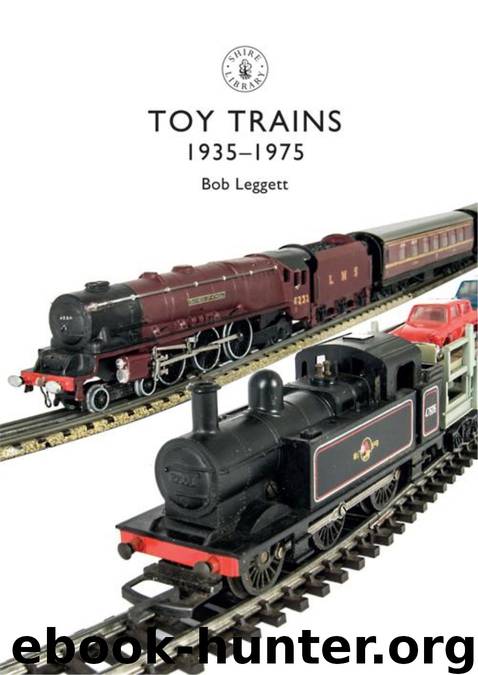Toy Trains by Bob Leggett

Author:Bob Leggett
Language: eng
Format: epub
ISBN: 9781784423094
Publisher: Bloomsbury Publishing
Published: 2019-11-23T16:00:00+00:00
The newly built factory constructed in Westwood, near Margate, Kent in the mid-1950s to cope with the rapidly expanding Tri-ang Railways. Today it is home to the Hornby Visitor Centre and is storage for main line locomotives.
A pair of Tri-ang Transcontinental pantograph double-ended locomotives on Neil Smith’s vintage layout.
Almost overnight, Meccano and Trix found they had a competitor with the power of a large company seriously to challenge their dominance in the post-war 00 gauge market. Richard considered Hornby Dublo a very competent competitor, but Tri-ang was big enough to compete with Dublo and Trix, neither of which realised the impact this new system would have on them.
Not only was Tri-ang a more imaginative and forward-thinking company than Meccano (Hornby Dublo), but it was also using the new material – plastic – which not only was cheaper, but could also be moulded into various colours with greater detail.
Tri-ang was able to invest heavily in the new system, which from the start was 2-rail, much more realistic than the Hornby Dublo and Trix 3-rail track. It also kept the clockwork sets in its portfolio, aimed at the younger market. These were compatible with the electric 2-rail system and benefited from owners staying with Tri-ang when upgrading to electric trains.
The Lines group was also keen to sell its system worldwide and introduced a Transcontinental system, predominantly aimed at the Canadian, South African, Australian and New Zealand market. So colourful and exciting was this range that the UK market also demanded the items, and in the 1950s this range was sold very successfully in Britain.
Tri-ang did not rest in the 1950s, producing new and colourful locomotives and rolling stock. Hornby Dublo launched the new BR livery in the 1950s, but a lack of imagination with a very limited choice of locomotives, rolling stock and accessories allowed Tri-ang to become the No.1 system by the end of the decade. The Meccano group in the 1950s suffered on all three of its toy fronts. Tri-ang competed with its trains; Mettoy’s Corgi toys (1955) seriously affected Dinky Toys; and Lego, launched in 1960, began the demise of the Meccano Construction and Bayko market. Sadly, as mentioned earlier, the Meccano chairman Roland Hornby did not have the flair, imagination and business acumen of his father Frank, and the Meccano company struggled during the latter half of the 1950s.
By 1960 Tri-ang was quoted as having around 50 per cent of the 00 gauge market, with Dublo, Trix and others controlling the rest. Dublo failed to launch 2-rail sets until 1959, however, keeping 3-rail in production, and as a result, despite some excellent new plastic buildings and more realistic 2-rail rolling stock, it struggled financially running two systems. It was also unable to stem losses from other parts of the business. Sadly, the Meccano Group went into liquidation. Tri-ang then purchased it and combined the two railway systems on 1 May 1965, becoming known as Tri-ang Hornby.
Download
This site does not store any files on its server. We only index and link to content provided by other sites. Please contact the content providers to delete copyright contents if any and email us, we'll remove relevant links or contents immediately.
| Automotive | Engineering |
| Transportation |
Whiskies Galore by Ian Buxton(41529)
Introduction to Aircraft Design (Cambridge Aerospace Series) by John P. Fielding(32888)
Small Unmanned Fixed-wing Aircraft Design by Andrew J. Keane Andras Sobester James P. Scanlan & András Sóbester & James P. Scanlan(32573)
Craft Beer for the Homebrewer by Michael Agnew(17933)
Turbulence by E. J. Noyes(7700)
The Complete Stick Figure Physics Tutorials by Allen Sarah(7137)
Kaplan MCAT General Chemistry Review by Kaplan(6595)
The Thirst by Nesbo Jo(6435)
Bad Blood by John Carreyrou(6274)
Modelling of Convective Heat and Mass Transfer in Rotating Flows by Igor V. Shevchuk(6222)
Learning SQL by Alan Beaulieu(6035)
Weapons of Math Destruction by Cathy O'Neil(5828)
Man-made Catastrophes and Risk Information Concealment by Dmitry Chernov & Didier Sornette(5645)
Digital Minimalism by Cal Newport;(5389)
Life 3.0: Being Human in the Age of Artificial Intelligence by Tegmark Max(5184)
iGen by Jean M. Twenge(5161)
Secrets of Antigravity Propulsion: Tesla, UFOs, and Classified Aerospace Technology by Ph.D. Paul A. Laviolette(4989)
Design of Trajectory Optimization Approach for Space Maneuver Vehicle Skip Entry Problems by Runqi Chai & Al Savvaris & Antonios Tsourdos & Senchun Chai(4839)
Electronic Devices & Circuits by Jacob Millman & Christos C. Halkias(4747)
